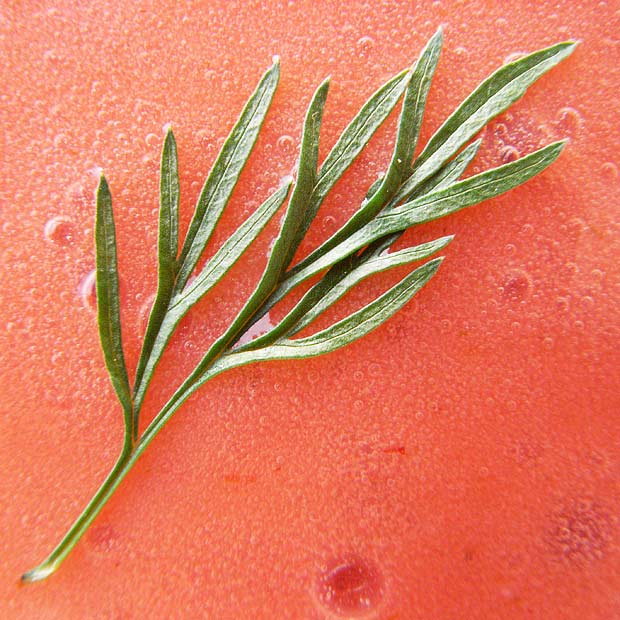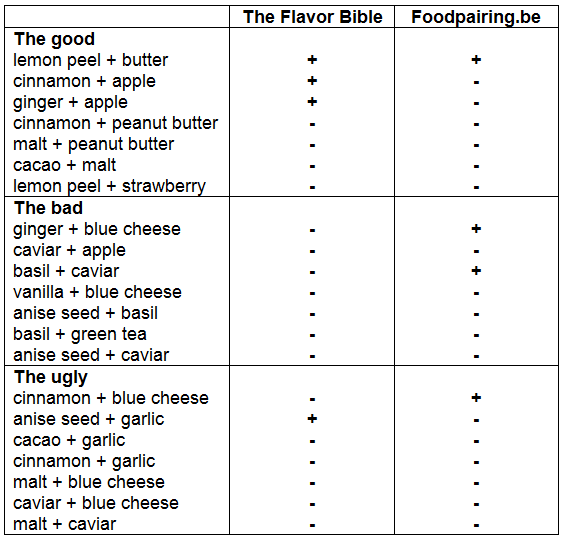
Foamy strawberries with coriander (cilantro) from TGRWT #3 turned out to be a delicious combination. Could it possibly be a category 2d predicted aroma similarity?
As mentioned in my previous post about the flavor pairing presentation given by Wender Bredie as part of the Copenhagen seminar on molecular gastronomy I’m really happy that the topic has been brought into the scientific community. At the same time is has also become very clear to me that the term flavor pairing needs some clarification. First of all I have come to realize that the the term flavor pairing is slightly misleading, and I wonder if aroma similarity perhaps is a more precise term. As I see it, today the term flavor pairing is used in a range of different ways:
- Empirically based pairings. These are the good combinations of ingredients (or even food and wine) that more or less all cooking relies on. An excellent source for such flavor pairings is The Flavor Bible. If one can talk about any chemical principles at all it would be related to balancing the basic tastes and using contrasting elements. But the pleasantness of the empirical based pairings are probably also often subject to the exposure effect – you get used to something and eventually start liking it.
- Predicted aroma similarity. This is the broad category that I’ve previously referred to as flavor pairing. It can be further subdivided into the following categories:
- Predicted aroma similarity based on overlap of one or a few volatiles
- Predicted aroma similarity based on the number of overlapping volatiles
- Predicted aroma similarity based on overlap between one or more of the high concentration volatiles
- Predicted aroma similarity based on overlap between high impact odorants (volatiles to compare are first selected based on OAV, AEDA, CHARM, FD …)
- Predicted aroma similarity based on similar neurological responses (as judged by fMRI or any other technique)
The reason I propose aroma similarity for category 2 is to avoid confusion with category 1. Also, such a term does not suggest that only combining the two will yield heavenly combinations. To a chef, it may even be the opposite, as foods or ingredients selected based on aroma similarity may be too similar if used by themselves. The predictive power in category 2 increases from 2a, 2b and 2c (where it is zero or very close to zero) to 2d and 2e (where predictions make sense). Personally I have always thought that what I previously referred to as flavor pairings should at least be of category 2d based on this, but I realize that I probably haven’t expressed this clear enough before. Another obvious reason to clarify the terms is of course that some of the discussion that arises around flavor pairing stems from different understandings and definitions of what flavor pairing is.
From what I’ve heard the flavor pairing examples Heston Blumenthal has come up with (or at least some of them) belong to category 2d/2e thanks to proprietary research that was made available to him. But since the background data has not been published (and probably never will be) it is difficult to evaluate this further. I also seem to remember that Heston has talked about flavor pairings of category 2a, 2b and/or 2c based on data from the VCF database (I think it was in one of the RSC videos). I do not know in which category the example from François Benzi (indole in jasmine and pork liver) belongs, but since indole was mentioned specifically it maybe category 2a unless indole is in fact present in high concentrations or even is a high impact odorant.
In the food blogging event They Go Really Well Together (TGRWT) I have tried to argue that flavor pairing at least should be based on category 2d types of pairings. But due to the very limited amount of data available it has not been possible to asses whether the pairings published by Heston actually do have an overlap of the impact odorants. From what I’ve heard the foodpairing website (old .be site, new .com site) put together by Bernard Lahousse and Lieven De Couvreur does incorporate threshold values and thereby is based on the impact/activity of the odors and hence falls into category 2d, but regrettably very little has been published about the underlying methodology used to create the website.
Let me also add that although I firmly believe that it makes sense to talk about activity or impact of odorants, I have previously addressed some of the limitations with odor activity values, and I quote myself:
It’s only fair enough to add that the concept of odor activity values has it’s limitations. Some are related to matrix effects, because thresholds are not necessarily recorded in a matrix mimicking the food product. Possible synergies between flavour compounds are disregarded (examples are known where sub-threshold concentrations are detected in the presence of other volatile compounds). Also, the underlying assumption that the odor intensity increases linearly is not quite correct. The typical intensity vs. concentration curve is more “˜S’ shaped with an expansive, linear and compressive region as shown below. At low concentrations (expansive region) synergism (also known as hyperadditivity or mutual enhancement) is observed. At high concentrations (compressive region) antagonism (or subadditivity or mutual suppression) is observed. This means that a high OAV overestimates and a low OAV underestimates the impact of the individual compounds.
The fact that Wender Bredie in his studies found absolutely no correlation between the hedonic score of the food pairings and the overlap of volatile flavors could at first be a little disappointing. But I believe the only conclusion that can be drawn using data from VCF (which has information about volatiles and some concentration data) is that type 2b/2c predictions are very weak. I strongly believe that one should take into account some kind of metric to filter out the odors that do not contribute to the overall aroma of the food.
For fun I checked Wender’s list of “the good, the bad and the ugly” using The Flavor Bible (a good source of category 1 flavor pairings) and the foodpairing website (presumably category 2c and/or 2d predictions). This is what I found:
It is interesting that The Flavor Bible (being purely empirical) actually mentions three of the “good” pairings. That it also mentions one of the “ugly” pairings is a good reminder that binary mixtures are not actually food and this real life is more complex. And it is also peculiar that all the garlic combinations were perceived as “ugly”. In a moussaka for instance one would combine cinnamon and garlic (with many other spices and herbs of course), and it is indeed quite delicious. Moving on to the predictions from foodpairing.be it is not so easy to draw any conclusions, but it is interesting that the four predicted aroma similarity pairs fall into the whole range of hedonic categories (i.e. ugly, bad and good). These could be interesting cases in a follow up study at lower concentrations as Wender mentioned in his presentation.
Based on the distinction between the different types of flavor pairing suggested above the flavor pairing hypothesis may be reformulated as follows: For foods with a predicted aroma similarity based on the analysis of it’s volatiles there is a good chance that they can be used together in a dish. Needless to say, the prediction should be of type 2d or 2e. Experience from the TGRWT rounds further suggests that some experimentation may be needed to find the right balance between the two and that contrasting elements are very important, otherwise the combination may turn out quite bland.
So to conclude: What I’m after from a gastronomical perspective is a tool to pair foods and suggest extra ingredients based on aroma similarity. This first and foremost becomes interesting if the combinations are novel or have a surprise element. Because of the aroma similarity the complexity of the combination will presumably be less than anticipated. Thinking about the Wundt curve (which I learnt about in Michael Bom Frøst’s presentation in Copenhagen – more on that in a separate post) which suggests that pleasantness first increases and then decreases with increasing complexity, a less than anticipated complexity combined with novelty/surprise could perhaps be what we are looking for when we try to create new and delicious food.


Speaking of TGRWT…
:p
[…] this information, I decided to do a flavour pairing experiment using “Predicted aroma similarity based on overlap of one or a few volatiles,” as Martin Lersch puts it, by combining maple syrup and curry powder in a basic shortbread […]
New update of Foodpairing.com website launched, where you have access to 100 dynamic Foodpairing trees; http://www.foodpairing.com/en/free-trial/
[…] Martin Lersch, Flavor pairing revisited [dostÄ™pne na blogu autora:] Khymos. […]